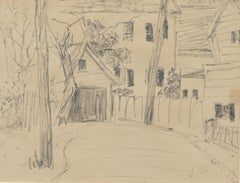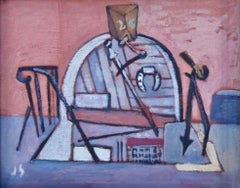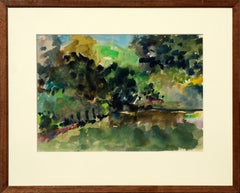Joseph Solman Landscape Paintings
American, 1909-1908
Brought to America from Russia as a child in 1912, Joseph Solman was a prodigious draftsman and knew, in his earliest teens, that he would be an artist. He went straight from high school to the National Academy of Design, though he says he learned more by sketching in the subway on the way back from school late at night: people “pose perfectly when they’re asleep.” In 1929, Solman saw the inaugural show at the Museum of Modern Art featuring Seurat, Gauguin, Van Gogh, and Cezanne. It changed his life – and his art. Joseph Solman was, with Mark Rothko, the unofficial co-leader of The Ten, a group of expressionist painters who exhibited as the “Whitney Dissenters” at the Mercury Galleries in New York in 1938. A champion of modernism, Solman was elected an editor of Art Front Magazine when its other editors, art historian Meyer Shapiro and critic Harold Rosenberg, were still partial to Social Realism In 1964, The Times, discussing his well-known subway gouaches (done while commuting to his some-time job as a racetrack pari-mutuel clerk), called him a “Pari-Mutuel Picasso.” In 1985, on the occasion of a 50-year retrospective, The Washington Post wrote: “It appears to have dawned, at last, on many collectors that this is art that has already stood the acid test of time.” We had the pleasure of the meeting the artist a few times at his home which was over the original Second Avenue Deli in the East Village.to
1
1
Overall Width
to
Overall Height
to
2
1
1
1
2
1
1
1
1
1
1
18
658
600
320
249
1
2
Artist: Joseph Solman
"Garage in Provincetown" Joseph Solman, Urban Landscape by Expressionist Artist
By Joseph Solman
Located in New York, NY
Joseph Solman
Garage in Provincetown
Signed with initials lower right
Graphite on paper
8 7/8 x 11 7/8 inches
Joseph Solman was born in 1909 in Vitebsk, in what is now Belarus, the...
Category
20th Century Abstract Expressionist Joseph Solman Landscape Paintings
Materials
Paper, Graphite
WPA American Scene Modernism 20th Century NYC Industrial "Cellar with Horseshoe"
By Joseph Solman
Located in New York, NY
"Cellar with Horseshoe" WPA American Scene Modernism 20th Century NYC Industrial
Joseph Solman (1909-2008) "Cellar with Horseshoe," 16 x 20 inches, oil on canvas
circa 1938, initial...
Category
1930s American Modern Joseph Solman Landscape Paintings
Materials
Canvas, Oil
Related Items
Mid Century Lake Anza Berkeley Bay Area Abstract Expressionist Landscape W/C
By Howard Margolis
Located in Soquel, CA
Brilliantly colorful mid century expressive abstracted landscape of Lake Anza in Berkeley by Bay Area artist Howard Margolis (American, 1927-2015). Signed “Margolis” in lower right c...
Category
Late 20th Century Abstract Expressionist Joseph Solman Landscape Paintings
Materials
Paper, Watercolor
Howard MargolisMid Century Lake Anza Berkeley Bay Area Abstract Expressionist Landscape W/C, c.1960s
$680 Sale Price
20% Off
H 10.75 in W 13.75 in D 0.5 in
City at Night (Cityscape)
By Abram Tromka
Located in Wilton Manors, FL
Abram Tromka (1895-1964)
City at Night, ca. 1940.
Oil on canvas, 16 x 20 inches; 20 x 24 inches in antique oak frame. Signed lower right.
Frame is of the period, but probably not ...
Category
1930s American Modern Joseph Solman Landscape Paintings
Materials
Canvas, Oil
Lily-of-the-Valley, Landscape
Located in Sungai Petani, Kedah
"Lily-of-the-Valley 1.0" is a beautiful original painting inspired by the joy and beauty of blooming flowers, reminiscent of a summer day in Kew Gardens. The artist's personal connec...
Category
21st Century and Contemporary Abstract Expressionist Joseph Solman Landscape Paintings
Materials
Canvas, Ink, Acrylic
Woman and Child in the Woods - Midcentury Abstracted Landscape in Oil on Canvas
Located in Soquel, CA
Woman and Child in the Woods - Midcentury Abstracted Landscape in Oil on Canvas
Dramatic abstracted painting of a woman holding a child in the woods by Maley (20th Century). This pi...
Category
1970s American Modern Joseph Solman Landscape Paintings
Materials
Canvas, Oil, Stretcher Bars
$2,500
H 26.5 in W 21 in D 1 in
Body in the Field #1 - 21st Century, landscape painting, blue, yellow, velvet
By Zsolt Berszán
Located in Baden-Baden, DE
Body in the Field #1, 202
oil on canvas
19 ¹¹/₁₆ H x 15 ³/₄ W in.
50 H x 40 W cm
Zsolt Berszán embodies in his works the dissolution of the human body through the prism of the fragm...
Category
2010s Abstract Expressionist Joseph Solman Landscape Paintings
Materials
Canvas, Oil
$1,892
H 50 in W 40 in D 2 in
Shanty Town
By Robert Noel Blair
Located in Buffalo, NY
You are viewing a modernist American acrylic painting depicting a charming but rundown seaside town at night.
Robert Noel Blair (American, 1912-2003) was an American artist, paint...
Category
1950s American Modern Joseph Solman Landscape Paintings
Materials
Acrylic, Archival Paper
"Search" by Andreas Claussen, Surreal Astronaut Painting
By Andreas Claussen
Located in Denver, CO
Andreas Claussen’s "Search" (2022) is a striking oil painting that blends surrealism and contemporary realism. Measuring 31.5 x 31.5 inches, this compelling work depicts a lone astro...
Category
2010s Abstract Expressionist Joseph Solman Landscape Paintings
Materials
Canvas, Oil
$4,500
H 31.5 in W 31.5 in
Head to Sea, Modernist sailing scene
By Ralph Eugene Della-Volpe
Located in New York, NY
A vibrant and yet romantic sailing scene which was a favorite series by Della-Volpe. His compelling colorist approach has made his works desirable as he was one of the few artists post-war to be representative in style like Milton Avery and Wolf Kahn. Head to Sea has the hallmark intense and lovely coloration for which Della-Volpe is known. He came out of Abstract Expressionism in the New York school but then pivoted, like Milton Avery to representational, colorist work. The frame is a silvered gold leaf float frame of quality and has a rubbed, antiqued surface...
Category
Early 2000s American Modern Joseph Solman Landscape Paintings
Materials
Oil, Board
Weehawken Sequence
By John Marin
Located in Bryn Mawr, PA
Weehawken Sequence, c. 1910-16
Oil on canvas board, 9 x 12 inches (22.9 x 30.5 cm)
Framed dimensions: 13 3/8 x 16 1/4 inches
John Marin’s long and prolific career is best marked by ...
Category
20th Century American Modern Joseph Solman Landscape Paintings
Materials
Canvas, Oil, Board
Time Is Your Garden. Large Contemporary Expressionist Oil Painting
Located in Brecon, Powys
Francesca Owen is an award winning contemporary fine art painter and a former Slade graduate where she studied under some influential artists such as Dame Phyllida Barlow RA CBE, And...
Category
2010s Abstract Expressionist Joseph Solman Landscape Paintings
Materials
Oil
$7,000
H 47.25 in W 47.25 in
Green Landscape, Abstract Countryside, Fields, Modern, Contemporary, Oil, French
By SOPHIE DUMONT
Located in LANGRUNE-SUR-MER, FR
Abstract landscape with colored plots in a dominant green. The landscape evolves in modulations with blurred contours, to suggest volumes more than to draw a precise pattern. The pal...
Category
21st Century and Contemporary American Modern Joseph Solman Landscape Paintings
Materials
Oil
$1,466 Sale Price
20% Off
H 14.97 in W 24.02 in D 0.79 in
Mid Century Bayside View, San Francisco
By Sally Kissinger Wilt
Located in Soquel, CA
Stunning large-scale, Bay Area Figurative School, painting of a woman sitting by a window overlooking a lakeside view, influenced by her teacher Richard Diebenkorn, by Sally Kissing...
Category
1960s Abstract Expressionist Joseph Solman Landscape Paintings
Materials
Canvas, Oil
Joseph Solman landscape paintings for sale on 1stDibs.
Find a wide variety of authentic Joseph Solman landscape paintings available for sale on 1stDibs. You can also browse by medium to find art by Joseph Solman in canvas, fabric, oil paint and more. Much of the original work by this artist or collective was created during the 1930s and is mostly associated with the modern style. Not every interior allows for large Joseph Solman landscape paintings, so small editions measuring 25 inches across are available. Customers who are interested in this artist might also find the work of John Ford Clymer, Donald Stacy, and Herbert Kornfeld. Joseph Solman landscape paintings prices can differ depending upon medium, time period and other attributes. On 1stDibs, the price for these items starts at $75,000 and tops out at $75,000, while the average work can sell for $75,000.


